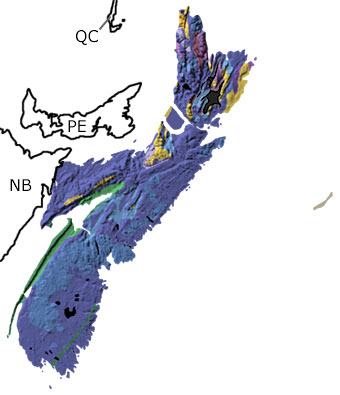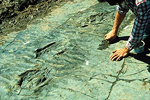Nova Scotia, Canada
|
|
|||||||||||||||||||||||||||||||||||||||||||||||||||||||||||||
Paleontology and geology
The Precambrian: Nova Scotia can be divided into two distinct geological regions by a large fault that runs from Cobequid Bay in the west to Cedabucto Bay in the east. Rocks of these regions are named after the microcontinents they are derived from. To the north is the Avalon Zone, to the south, the Meguma Zone. During the Precambrian, not much of Nova Scotia existed. The northwestern tip of Cape Breton Island was part of Laurentia and lay near the equator. These metamorphic rocks belong to the Grenville Group and are part of the Canadian Shield. The rest of the Avalon Zone was just beginning to form. It started as a series of island arcs off the coast of Gondwana, which lay near the South Pole. The Meguma microcontinent had not formed yet.
The Paleozoic: The microcontinents, Avalonia and Meguma, broke away from Gondwana and collided with Laurentia at separate times. Every collision created mountains and generated substantial igneous activity. Volcanoes deposited lava and ash on the surface, and magma intruded under older rocks. Shallow seas filled with trilobites, brachiopods, crinoids, graptolites, and fish covered some areas of Nova Scotia. Fossils of plants, insects, early amphibians and reptiles, and many trackways, record a landscape of swamps, wetlands, and forests on the land. By the end of this era, Nova Scotia was uplifted as all the continents collided to form Pangea.
The Mesozoic: After Pangea formed, it soon began to break up, opening the Atlantic Ocean east of Nova Scotia. This rifting created many basins, including the Bay of Fundy. In areas where the crust was very thin, lava erupted and flooded the basins. Rivers, lakes, and dunes also developed in the basins. They preserve fossils of the plants, dinosaurs, early crocodiles, and mammal-like reptiles that lived here. There are few deposits from the Mesozoic in Nova Scotia because erosion removed most of them.
The Cenozoic: There are no Tertiary age rocks on land in Nova Scotia; however, they can be found offshore on the continental shelf. Glaciers from the Quaternary shaped the modern landscape of this province. They eroded, smoothed, and gouged exposed rocks. As the glaciers melted, they deposited sediments in the shape of rounded hills, called drumlins. Quaternary rocks have yielded fossils of plants, turtles, fish, and mastodons. Marine sands with bivalve fossils on land record times when sea level was higher.
Links to more on Nova Scotia paleontology
Collecting and Legalities | Organizations | Education and Exhibits | Resources
Collecting and LegalitiesOrganizationsLaws on Fossil Collecting (showing 1 of 1 listings)
Special Places Protection Act: This act gives Nova Scotia's Heritage Division the mandate to protect important archaeological, historical and paleontological sites and remains, including those underwater.
Education and ExhibitsSocieties and Clubs (showing 1 of 1 listings)
Geological Association of Canada's Paleontology Division: The division's activities, publications, and goals.
Museums (showing 1 of 1 listings)
Joggins Fossil Centre: The Centre features a museum which highlights the fossil record of the Carboniferous Period. Specimens from Joggins are on display illustrating the great diversity of life preserved in the Joggins Fossil Cliffs. Guided tours of the site are also available.
ResourcesVirtual Exhibits (showing 2 of 2 listings)
Project Prosauropod at the Fundy Geological Museum: Watch as Canada's oldest dinosaur is uncovered at the Fundy Geological Museum in Parrsboro, Nova Scotia. The site is updated weekly and includes pictures from fieldwork at Wasson's Bluff.
The Dawn of Animal Life: While most people know of the dinosaurs from a mere 70 million years ago, very few are aware that the Earth's fossil record stretches over 3 billion years into the past. Using exclusively Canadian rocks and fossils, this exhibit highlights almost three billion years of early evolution when only simple, soft-bodied creatures inhabited the Earth.
Field Guides (showing 1 of 1 listings)
An Introduction to the Geological History of Nova Scotia: Download a pdf that provides a thorough examination of Nova Scotia's geologic history.
General Reference (showing 2 of 2 listings)
Enchanted Learning's Dinosaur Fossils Found in Canada: A list of dinosaurs found in Canada, by province.
The Trace Fossil Mystery: This site helps explain the origins of trace fossils found in eastern Canada.

